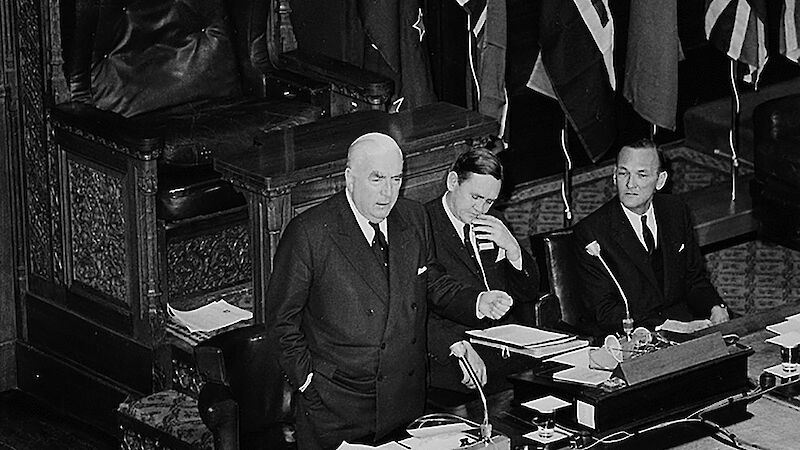Scientists and politicians fall into step
In the late 1940s, rivalry between nations claiming territory in the Antarctic Peninsula region showed signs of developing into open conflict. At the same time, some nations were fearful that the region would become a pawn in the Cold War between the United States and the Soviet Union, both of which had significant Antarctic interests.
Diplomats began to talk seriously about a treaty governing Antarctic affairs, and scientists used the opportunity to obtain nations’ support for a major effort to set up scientific programs on the continent. The International Geophysical Year, or IGY (which actually lasted 18 months, from July 1957 to December 1958) was highly successful, but its scientific advances raised many unanswered questions and made it clear that the Antarctic research effort would need to be continued.
In 1958 the International Council of Scientific Unions (ICSU) established the Special Committee on Antarctic Research (SCAR) to provide an international coordinating body for Antarctic science. At its first meeting in 1958 it was charged with “furthering the coordination of scientific activity in the Antarctic, with a view to framing a scientific program of circumpolar scope and significance.” Australia was one of its original 12 members.
Australia’s key role
The IGY success was not lost on the politicians and diplomats of Antarctic nations. The United States had instigated negotiations for some sort of international regime for the Antarctic, but they came up against several obstacles including Cold War politics and the territorial claims of 7 countries, including Australia.
Australia had a key role in the complex negotiations that resolved these issues and led to the signing of the Antarctic Treaty in 1959. As a reward for its effort, Australia hosted the first meeting of Treaty member nations, held in Canberra in 1961 under the chairmanship of then-Senator John Gorton.
An exceptional agreement
In the context of the period in which it was negotiated, the Antarctic Treaty is an exceptional agreement. Coming not long after the launch of Russia’s Sputnik, at the height of the Cold War, the prospects for success of the Treaty negotiations could hardly have been less likely. Yet the 12 original signatory nations, Argentina, Australia, Belgium, Chile, France, Japan, New Zealand, Norway, South Africa, the United Kingdom, the United States of America and the Soviet Union, managed to put their differences aside and agree on a common cause.
The Treaty, open to any member of the United Nations, now encompasses additional member states with Consultative Party status (the 12 original signatories plus other countries with substantial Antarctic research programs) and a similar number of Non-Consultative Parties.
SCAR (now the Scientific Committee on Antarctic Research) grew with the Antarctic Treaty. Throughout the Treaty’s 6 decades, it has continued to provide independent scientific advice to Treaty members and coordinating international and multidisciplinary scientific programs in the Antarctic.
Protecting this special place
Protection of the Antarctic environment and ecosystems is in the interest of humankind as a whole. This was declared by the Treaty nations in the preamble to the historic Protocol on Environmental Protection to the Antarctic Treaty signed in Madrid in 1991 and entering into force in early 1998. The ‘Madrid Protocol’, as it became known, was the culmination of a growing consciousness among the Antarctic nations of both the global importance of the Antarctic environment and the need to protect this for its own sake.
As early as 1964 Antarctic nations, including Australia, recognised the importance of conservation measures in the Antarctic in initiating the Agreed Measures for the Conservation of Antarctic Fauna and Flora PDF at the third Antarctic Treaty Consultative Meeting. The measures provided for overall protection of native animals and plants while establishing a system of managed protected areas.
In 1978, the Convention for the Conservation of Antarctic Seals PDF provided a means for regulating commercial sealing should it ever resume, fully protecting 3 Antarctic seal species and establishing catch limit mechanisms for the other 3.
Around the same time negotiations began for a more comprehensive convention governing marine living resources in Antarctic waters. The Convention on the Conservation of Antarctic Marine Living Resources (CCAMLR), concluded in 1980, established one of the world’s first conservation agreements which seeks to manage the whole ecosystem rather than just individual commercially harvested species. Australia hosts the CCAMLR secretariat (the only international convention with headquarters in Australia), whose member states meet each year in Hobart.
The Madrid Protocol: a singular achievement
Australia decided in 1989 that it would not ratify a planned regime to control mineral resource activity in Antarctica, but instead opted to seek the support of Antarctic Treaty countries for full environmental protection for the continent and its surrounding seas. The Madrid Protocol, signed by Treaty members in that city in 1991, was a direct result of this initiative pursued by Australia, France, Italy and Belgium. It was a landmark agreement in the history of the Antarctic Treaty.
The Protocol places an indefinite ban on mining or mineral resource activity in Antarctica PDF, designating the Antarctic as a natural reserve devoted to peace and science. It provides a multinational, codified set of environmental standards (Antarctica is the only continent for which this applies), and creates a new system of protected areas. The Protocol establishes environmental principles for the conduct of all activities, which must be assessed for their potential environmental impact before they are undertaken, and provides guidelines for conservation of Antarctic flora and fauna, managing and disposing of waste, and preventing marine pollution.
As a signatory to the Protocol, Australia acted quickly to impose stronger environmental protection measures to its Antarctic activities, notably through introduction of an environmental impact assessment process. In 1994 Australia completed enactment of legislation to ratify the Protocol, which means that all Australians are bound by law to observe its provisions.

